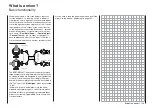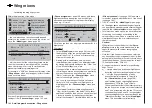
172
Detail program description - Wing mixers
Note:
The Offset, i.e. the activation direction, is also set in
the »
Model type
« menu, pager 94. This offset should
be set to about +90 % of stick travel (if the C1 joystick
is used, this is generally located at the forward
position of the stick). To extend the fl aps, the stick
must therefore be moved back towards the pilot. The
remaining joystick travel of around 10 % then has no
effect, although it is not "lost", since the control travel
is automatically expanded back to 100 %.
Use the select fi elds of the columns labeled "AILE",
"FLAP", "FL" and, if present, "FL2" to specify the
extent and the direction that corresponding fl ap
pairs are to follow when the airbrake control (control
function 1, 7, 8 or 9) is operated. If the model has no
airbrakes, leave the corresponding receiver output
free or set it in the »
Mix only channel
« menu to
"MIXonly" to be able to use it elsewhere.
Values in the range -150 % to +150 % are possible.
A simultaneous tap on the
cd
or
ef
keys of the
right touch pad (
CLEAR
) will reset the given active
(inverse video) fi eld to its default value shown in the
fi gure.
"AILE" column
•
When braking the model as it comes in to land,
neither of the two aileron fl aps should ever be
defl ected more than half of the possible travel
upwards, to ensure that enough travel is available
to control the model along its longitudinal axis
(aileron function).
AI
FL
FL2
FL2
FL
AI
"FLAP" (and "FLAP2") column
•
As the model is braked on the landing approach,
both pairs of fl aps can be set to defl ect by different
amounts, e.g.:
AI
FL
FL2
FL2
FL
AI
AI
FL
FL2
FL2
FL
AI
Combining AILE and FLAP for "Crow"
•
AI
FL
FL2
FL2
FL
AI
Though the airbrake mixers are set as described
above, there is a special fl ap constellation, called
"crow position"
or
"butterfl y"
, that can also be set. This
airbrake setting causes both
ailerons move moderately
upward while the fl aps move downward as far as
possible.
Another mixer – see below, under the section
"Elevat. curve" – is then used to trim the elevator such
that the fl ight speed does not change signifi cantly in
comparison to the normal fl ight position. Otherwise,
there is a danger that the model loses too much speed
and then, after the braking system is retracted (e.g.
to extend a landing approach that was too short, for
example), pancakes or even stalls.
A tip for "seeing" the effect of brakes:
lift the fl aps and look over and under the surface from
the front. The larger the surface projected by the lifted
fl ap, the greater the braking effect achieved.
Tips for activating airbrakes:
When, in addition to aileron and camber fl ap
•
servos, there is also a built-in servo for actuating
wing airbrakes, it can be most simply connected
to that receiver output – if free – whose input has
been selected for the brake function, i.e. either
on 1, 7, 8 or 9. If this is not possible then, as
an alternative, use a free mixer to connect the
selected brake control channel with the airbrake
servo.
To activate two airbrake servos, the best approach
•
is to leave one servo on output 1 and to connect
the second servo to a free output of your choice
– for example, output 9. You then also assign this
output to transmitter control 1 (as standard) on the
»
Control adjust
« menu, page 108, see fi gure.
0%
+100%
I9
I10
I11
I12
Typ SEL
+100%
0.0 0.0
–
–time+
0%
+100%
+100%
0.0 0.0
0%
+100%
+100%
0.0 0.0
0%
+100%
+100%
0.0 0.0
GL
GL
GL
Cn1
---
fr
fr
fr
---
---
---
offset
GL
Nor mal
As you do, leave the settings for offset, travel,
etc. at their default values. Also leave the default
"GL" value in the column labeled "TYP" so that
the second airbrake, like the fi rst, operates in the
same way across all fl ight phases.
Summary of Contents for 32032
Page 1: ...33020 mc 20HoTT 2 en Programming Manual o Pro Pro mc 20 mc 20...
Page 15: ...15 For your notes...
Page 21: ......
Page 27: ...27 For your notes...
Page 41: ...41 For your notes...
Page 53: ...53 For your notes...
Page 59: ...59 For your notes...
Page 63: ...63 For your notes...
Page 93: ...93 For your notes...
Page 97: ...97 For your notes...
Page 141: ...141 How is a ight phase programmed...
Page 145: ...145 For your notes...
Page 155: ...155 For your notes...
Page 175: ...175 For your notes...
Page 203: ...203 For your notes...
Page 219: ...219 For your notes...
Page 253: ...253 For your notes...
Page 283: ...283 For your notes...
Page 321: ...321 For your notes...
Page 322: ...322 For your notes...
Page 323: ...323 For your notes...
















































